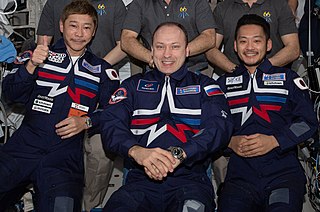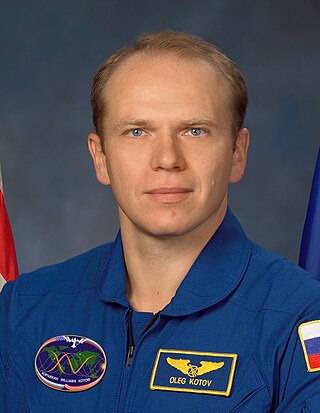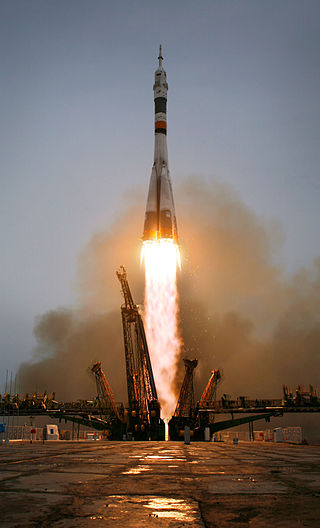
Space tourism is human space travel for recreational purposes. There are several different types of space tourism, including orbital, suborbital and lunar space tourism. Tourists are motivated by the possibility of viewing Earth from space, feeling weightlessness, experiencing extremely high speed and something unusual, and contributing to science.

Robert Brent "Bob" Thirsk, is a Canadian retired engineer and physician, and a former Canadian Space Agency astronaut. He holds the Canadian record for the most time spent in space. He became an officer of the Order of Canada (OC) in 2013 and was named to the Order of British Columbia (OBC) in 2012.

Space Adventures, Inc. is an American space tourism company founded in 1998 by Eric C. Anderson. Its offerings include zero-gravity atmospheric flights, orbital spaceflights, and other spaceflight-related experiences including cosmonaut training, spacewalk training, and launch tours. Plans announced thus far include sub-orbital and lunar spaceflights, though these are not being actively pursued at present. Nine of its clients have participated in the orbital spaceflight program with Space Adventures, including one who took two separate trips to space.

Yury Valentinovich Lonchakov is a Russian former cosmonaut and a veteran of three space missions. He has spent 200 days in space and has conducted two spacewalks. From 2014 to 2017, Lonchakov served as head of the Yuri Gagarin Cosmonaut Training Center.

André Kuipers is a Dutch physician and ESA astronaut. He became the second Dutch citizen, third Dutch-born and fifth Dutch-speaking astronaut upon launch of Soyuz TMA-4 on 19 April 2004. Kuipers returned to Earth aboard Soyuz TMA-3 11 days later.

Scott Joseph Kelly is an American engineer, retired astronaut, and naval aviator. A veteran of four space flights, Kelly commanded the International Space Station (ISS) on Expeditions 26, 45, and 46.

Valeri Ivanovich Tokarev is a Russian Air Force colonel and test cosmonaut at the Yuri A. Gagarin Cosmonaut Training Center. Tokarev traveled to space twice, and has performed two career spacewalks, before retiring in June 2008.

Charles Simonyi is a Hungarian-American software architect.

Soyuz TMA-7 was a transport mission for portions of the International Space Station (ISS) Expedition 12 crew launched October 1, 2005. The flight delivered ISS Commander William McArthur and ISS Flight Engineer Valery Tokarev to the station to replace Expedition 11 crew members. Spaceflight Participant Gregory Olsen joined the TMA-7 crew for the ascent and docking with the ISS, spent approximately eight days aboard conducting experiments, then returned to Earth with the outgoing members of Expedition 11 aboard Soyuz TMA-6. McArthur and Tokarev were joined on their return trip to Earth by Flight Engineer Marcos Pontes who launched aboard Soyuz TMA-8 and spent approximately seven days aboard the ISS conducting experiments for the Brazilian Space Agency.

Expedition 12 (2005) was the 12th expedition to the International Space Station, launched from Kazakhstan using the Russian Soyuz TMA-7 spacecraft. The crew landed back in Kazakhstan on 8 April 2006 with the addition of the first Brazilian astronaut, Marcos Pontes.

Oleg Valeriyevich Kotov was born on 27 October 1965 in Simferopol, Crimean oblast in the Ukrainian SSR. After a career as a physician assigned to the Soviet space program, he joined the Russian cosmonaut corps. He has flown three long duration spaceflights on the International Space Station logging over 526 days in space. Most recently, Kotov flew on the Soyuz TMA-10M/Expedition 37/Expedition 38 long duration spaceflight, from September 2013 until March 2014.

Shannon Walker is an American physicist and a NASA astronaut selected in 2004. She launched on her first mission into space on June 25, 2010, onboard Soyuz TMA-19 and spent over 163 days in space.

Alexander Alexanderovich Misurkin, a major in the Russian Air Force, is a Russian cosmonaut, selected in 2006. He flew aboard Soyuz TMA-08M on 28 March 2013 as his first space mission, and launched on Soyuz MS-06 as his second flight, in 2017. He was commander of the International Space Station for Expedition 54.

Oleg Dmitriyevich Kononenko is a Russian cosmonaut. He has flown to the International Space Station five times as a flight engineer for Expedition 17 aboard Soyuz TMA-12, as a flight engineer on Expedition 30 and commander of Expedition 31 aboard Soyuz TMA-03M, as a flight engineer on Expedition 44 and Expedition 45 aboard Soyuz TMA-17M, as a flight engineer on Expedition 57 and commander of Expedition 58 and Expedition 59 aboard Soyuz MS-11, and as a flight engineer on Expedition 69 and Expedition 70 and commander of Expedition 71 aboard Soyuz MS-24/Soyuz MS-25.

Sergey Aleksandrovich Volkov is a retired Russian cosmonaut and engineer. He was a member of three missions to the International Space Station, spending more than a year in total in space. During his missions he did four spacewalks lasting more than 23 hours in total. Volkov retired from the Cosmonaut group in February 2017.

The Soyuz TMA-14 was a Soyuz flight to the International Space Station, which launched on 26 March 2009. It transported two members of the Expedition 19 crew as well as spaceflight participant Charles Simonyi on his second self-funded flight to the space station. TMA-14 was the 101st crewed flight of a Soyuz spacecraft, including launch failures; however, it was the 100th to launch and land crewed, as Soyuz 34 was launched uncrewed to replace Soyuz 32, which landed empty.

The Soyuz TMA-16 was a crewed flight to and from the International Space Station (ISS). It transported two members of the Expedition 21 crew and a Canadian entrepreneur from the Baikonur Cosmodrome in Kazakhstan to the ISS. TMA-16 was the 103rd flight of a Soyuz spacecraft, the first flight launching in 1967. The launch of Soyuz TMA-16 marked the first time since 1969 that three Soyuz craft were in orbit simultaneously.

Soyuz TMA-18M was a 2015 Soyuz spaceflight to the International Space Station. It provided the two twelve-months occupants at the International Space Station with a fresh Soyuz capsule. TMA-18M was the 127th flight of a Soyuz spacecraft; the first having occurred in 1967. The ascent flight consisted of a Russian commander and two flight engineers from Denmark (ESA) and Kazakhstan respectively. The flight launched in September 2015 and returned to Earth in March 2016.

Soyuz MS-20 was a Russian Soyuz spaceflight to the International Space Station (ISS) on 8–20 December 2021. Unlike previous Soyuz flights to the ISS, Soyuz MS-20 did not deliver any crew members for an ISS Expedition or serve as a lifeboat for any crew members on board the station. Instead, it was commanded by a single professional cosmonaut and carried two space tourists represented by company Space Adventures, which had executed eight space tourism missions to the ISS in 2001–9. The flight to reach the ISS took six hours.



















